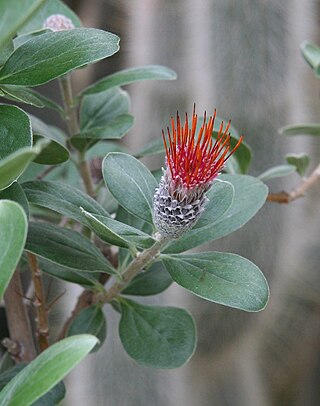
Alstroemeriaceae is a family of flowering plants, with 254 known species in four genera, almost entirely native to the Americas, from Central America to southern South America. One species of Luzuriaga occurs in New Zealand, and the genus Drymophila is endemic to south-eastern Australia.

Weberbauerella is a South American genus of flowering plants in the legume family, Fabaceae. It includes three species of perennial herbs or subshrubs native to coastal Peru and northern Chile. They grow in seasonally-dry tropical coastal forest, on sand or sandy hills. It was recently assigned to the informal monophyletic Dalbergia clade of the Dalbergieae.

Pennisetum is a widespread genus of plants in the grass family, native to tropical and warm temperate regions of the world. They are known commonly as fountaingrasses. Pennisetum is considered a synonym of Cenchrus in Kew's Plants of the World Online.

Mauritia flexuosa, known as the moriche palm, ité palm, ita, buriti, muriti, miriti (Brazil), canangucho (Colombia), morete or acho (Ecuador), or aguaje (Peru), is a palm tree. It grows in and near swamps and other wet areas in tropical South America.

Nolana is a genus of hard annual or perennial plants in the nightshade family. The genus is mostly native to Chile and Peru. Species in this genus, especially N. paradoxa, serve as a model system for studies on flower color.

Desmoncus is a genus of mostly climbing, spiny palms native to the Neotropics. The genus extends from Mexico in the north to Brazil and Bolivia in the south, with two species present in the southeastern Caribbean.

Prestoea is a genus of palms native to the Caribbean, Central and South America. Its range extends from Nicaragua and the Greater Antilles in the north to Brazil and Bolivia in the south.
Pappobolus is a genus of flowering plant in the family Asteraceae native to the Andes Mountains of Colombia, Ecuador, and Peru.

Wettinia is a genus of flowering plants in the palm family Arecaceae. The genus, established in 1837, contains some 20 species, but more seem to await discovery considering that 4 species - W. aequatorialis, W. lanata, W. minima and W. panamensis - were described as late as 1995. The genus is broadly divided into two groups. One group has the fruits tightly packed, while the other, formerly classified as genus Catoblastus, has fruits scattered along the inflorescence branches. It is not known whether these groups are both monophyletic. The genus is named after Frederick Augustus II of Saxony, of the House of Wettin.

Palaua is a genus of malvaceous plants native to the Andes. It shares with Malope and Kitaibelia the property of possessing capitate schizocarps, and was formerly classified with them in a subfamily Malopoideae or tribe Malopeae. It is now considered to be more closely related to Sphaeralcea, and to other Andean mallows.

Iriartella is a genus of two species of palms found in northern and northwestern South America. The Nukak people of Colombia use Iriartella setigera to fashion blowguns.

Socratea is a genus of five species of palms found in tropical Central America and South America.

Pholidostachys is a genus of palms found in Central America and northwestern South America.

Welfia is a genus of palms found in Central America and northwestern South America. Only two species are currently recognized: Welfia regia and Welfia alfredii.

Ismene, or Peruvian daffodil, is a genus of South American plants in the Amaryllis family. The species are native to Peru and Ecuador and widely cultivated elsewhere as ornamentals because of their large, showy flowers.

Arnaldoa is a genus of flowering plants in the aster family, Asteraceae. It is native to Ecuador and Peru.

Ferreyra is a surname meaning 'smith'. Notable people with the surname include:

Stenomesson is a genus of bulbous plants in the family Amaryllidaceae. All the species are native to western South America.

Weberbauerella brongniartioides is a South American species of flowering plant in the family Fabaceae.

Weberbauerella chilensis is a legume species taxonomically similar to W. brogniartiodes; with a prostrate habit and shorter leaflets.


















